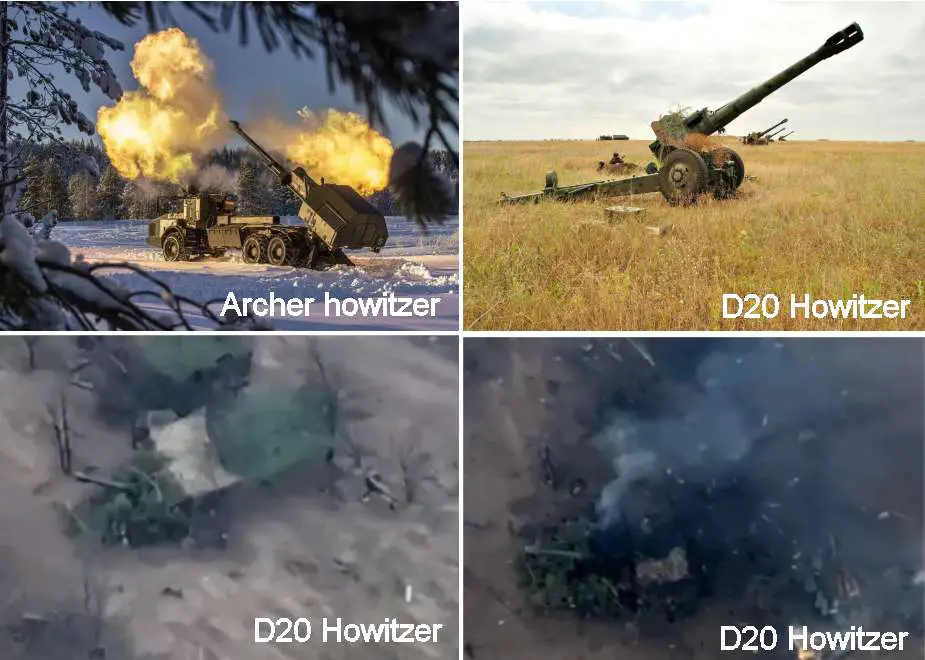- Army
- Conflicts in the world
- Israel - Iran conflict 2025
- Pakistan - India Conflict 2025
- Russia Ukraine War 2022
- Libya conflict day by day
- HAMAS - Israel War 2023
- Operation Serval in Mali French Army
- Sangaris operation Central African Republic
- Sangaris opération militaire République Centreafrique
- Ukraine - Russia conflict
- Syria conflict news
- Defence & Security Industry Technology
- Armies in the world
- Analysis Defense and Security Industry
- Conflicts in the world
- Navy
- Air
Ukraine's Archer howitzer destroys three Russian D20 artillery pieces with counter-battery fire
On March 10, 2024, the Ukrainian 45th Artillery Brigade utilized its social media platforms to share a video showcasing the successful counter-battery operation against three Russian 152mm D20 howitzers stationed in the Kreminna region, achieved using a Swedish-supplied Archer self-propelled gun.
Follow Army Recognition on Google News at this link

Archer howitzer destroys three Russian D20 artillery pieces with counter-battery fire (Picture source: Army Recognition and Ukraine Social Media)
This operation was made possible through precise coordinates provided by the aerial reconnaissance unit, leading to the targeted destruction of the enemy artillery positioned west of Kreminna. The Archer system's rapid deployment capability, which includes a preparation time of merely 20 seconds before firing and the ability to discharge three rounds in 20 seconds and exhaust its 21-round ammunition stockpile within three minutes, was highlighted, showcasing its substantial firepower and battlefield responsiveness.
This mission's accomplishment emphasizes the effective cooperation within units of the Ukrainian military, particularly through a joint operation with the 63rd Mechanized Brigade's aerial reconnaissance unit, which played a pivotal role in accurately locating the camouflaged enemy howitzers, thereby enabling a focused and efficient strike.
Sweden's contribution of eight Archer 155mm wheeled self-propelled howitzers has significantly enhanced the Ukrainian military's artillery capabilities amid its ongoing conflict with Russian forces. The Swedish Ministry of Defense confirmed this delivery on November 4, 2023, as a part of Sweden's continued military support to Ukraine, which has amounted to approximately $2 billion since the conflict's onset.
Russian troops utilizing Soviet-era D20 howitzers face several disadvantages against modern artillery systems like the Swedish-supplied Archer. Developed in the 1950s, the D20 has a maximum range of 17.4 km with standard ammunition and can achieve greater distances with rocket-assisted projectiles. Although capable of firing various ammunition types, including precision-guided munitions, its rate of fire is limited to about five rounds per minute, with a sustained capability of 65 rounds per hour. This system requires a crew of eight to ten personnel and is typically towed by a URAL-375 6×6 truck, thus limiting its mobility and rapid response capability. Such characteristics make it vulnerable in modern combat environments where mobility and the ability to swiftly engage after repositioning ("shoot and scoot") are critical for survival against drones and enemy artillery.
In comparison, the Archer howitzer, produced by BAE Systems Bofors, represents a state-of-the-art 155mm wheeled self-propelled artillery system originally designed for the Swedish Armed Forces. Mounted on a modified Volvo A30D all-terrain articulated hauler chassis, the Archer boasts exceptional mobility and maneuverability. It is equipped with a fully automated 155mm/L52 gun and a modular charge system, allowing for the utilization of a broad range of ammunition types. It's automated loading mechanism and high mobility enable quick deployment and repositioning, crucial in contemporary warfare scenarios. Capable of reaching speeds up to 70 km/h and with an operational range of approximately 500 km, the Archer adapts well to diverse combat situations.
Regarding firepower, the Archer exhibits formidable capabilities, achieving a maximum firing range of around 40 km with standard munitions and up to 60 km with precision-guided munitions. Its firing rate is noteworthy, with the capacity to fire up to 8 rounds per minute. Moreover, the Archer can conduct Multiple Rounds of Simultaneous Impact (MRSI) operations, where several shells are launched to concurrently hit a target. The system's advanced fire control and automated targeting features ensure precise and efficient engagement.
Notably, the Archer units provided to Ukraine have been modified to suit local conditions, including special Barracuda camouflage, though they lack a remotely controlled machine gun turret. This enhancement to the 45th Artillery Brigade's arsenal complements the Western artillery systems available to Ukraine, such as the FH70 and M777, thereby improving its capability to counter threats and support military operations across various fronts.
The ongoing conflict between Ukraine and Russia underscores the pivotal role of artillery in modern warfare, indicating a shift from anticipated high-tech military engagements to a traditional artillery duel. Despite introducing advanced weapon systems, the absence of Russian air superiority has necessitated reliance on ground-based artillery tactics. With both nations' military strategies deeply rooted in the Soviet era, the importance of mobility and rapid repositioning in warfare is highlighted.
Ukraine, grappling with the limitations of its Soviet-era artillery and scarce ammunition, has benefited from significant international support, including the provision of modern artillery systems and munitions from NATO countries. This assistance has been instrumental in addressing the disparity in artillery capabilities between Russia and Ukraine, emphasizing the continued strategic importance of artillery in current conflicts.


























